| Pages:
1
..
13
14
15
16 |
B(a)P
International Hazard
    
Posts: 1117
Registered: 29-9-2019
Member Is Offline
Mood: Festive
|
|
Aluminium is less desirable as you can get so many different types, so it is hard to make comparisons.
Mild steel is a consistent product so that would be the better choice.
Most importantly you want a material that is consistent. Lead is a desirable test medium as it has been used as a test medium for so long, you can
compare your results with the results in literature. Lead is used preferentially as it is easy to shape and handle, soft, but not too soft.
|
|
|
Laboratory of Liptakov
International Hazard
    
Posts: 1339
Registered: 2-9-2014
Location: Technion Haifa
Member Is Offline
Mood: cool.gif
|
|
Lead block has universal using. For example for blacksmith method creating copper cone. Source of metal, the weighing for models, Hess test of
brisance, Trauzl test for working power of EM. Projectiles and etc. Every researcher must have at home minimal 5 Kg of Lead....
Development of primarily - secondary substances CHP (2015) Lithex (2022) Brightelite (2023) Nitrocelite (2024)
|
|
|
untrained professional
Harmless

Posts: 3
Registered: 4-3-2024
Member Is Offline
|
|
I’m curious if anyone knows how far commercial detonators penetrate mild steel like the no.6, no.8, M6, M7 and M100 or other countries versions. It
would be useful knowledge to compare tests results to.
|
|
|
Nu0p
Harmless

Posts: 12
Registered: 25-3-2024
Member Is Offline
Mood: Curious, Determined
|
|
Sharing my first go at making a detonator.
Created 3 detonator caps using the 6x50mm cardboard tubes (bottle rocket tubes). Secondary is NQ mixed with 4% PTFE powder. Primary was NAP (native
crystal morpology). The ends were sealed with scotch tape. Will eventually investigate plastidip. Tape did work well for keeping the powder in while
loading and pressing. Pressed using 5.7mm HS steel rod and an arbor press. I didn’t work on good sealing, this is a very simple prototype.
- #1 was loaded with 750 mg NQ pressed to 1.0 g/cc and topped with 100 mg NAP.
- 75 mg NAP was pressed onto NQ, remaining 25 mg was loose and in contact with FF mix on the electronic match.
- #2 was loaded with 750 mg NQ pressed to 1.4 g/cc. Topped with 100 mg NAP.
- 50 mg NAP was pressed lightly into NQ, 50 mg loose in contact with FF mix on e-match.
- #3 was loaded with 750 mg NQ pressed to 1.4 g/cc. Topped with 100 mg NAP.
- 75mg pressed, 25 mg loose in contact with 5mm safety fuse.
I have metal casings but I wanted to make learn to use the cardboard. Hopefully it works. Hopefully the NQ detonates, not sure about that one yet. I
intend to set these off on top of lead blocks. I expect about 5.5 KMS. Not the highest, but enough to evaluate.
ETN, PETN, and RDX are planned for testing as well when I get to it. Results to come. Stay tuned.
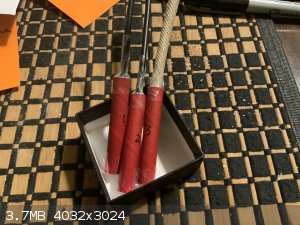
[Edited on 18-4-2024 by Nu0p]
|
|
|
MineMan
National Hazard
   
Posts: 998
Registered: 29-3-2015
Member Is Offline
Mood: No Mood
|
|
Quote: Originally posted by Nu0p  | Sharing my first go at making a detonator.
Created 3 detonator caps using the 6x50mm cardboard tubes (bottle rocket tubes). Secondary is NQ mixed with 4% PTFE powder. Primary was NAP (native
crystal morpology). The ends were sealed with scotch tape. Will eventually investigate plastidip. Tape did work well for keeping the powder in while
loading and pressing. Pressed using 5.7mm HS steel rod and an arbor press. I didn’t work on good sealing, this is a very simple prototype.
- #1 was loaded with 750 mg NQ pressed to 1.0 g/cc and topped with 100 mg NAP.
- 75 mg NAP was pressed onto NQ, remaining 25 mg was loose and in contact with FF mix on the electronic match.
- #2 was loaded with 750 mg NQ pressed to 1.4 g/cc. Topped with 100 mg NAP.
- 50 mg NAP was pressed lightly into NQ, 50 mg loose in contact with FF mix on e-match.
- #3 was loaded with 750 mg NQ pressed to 1.4 g/cc. Topped with 100 mg NAP.
- 75mg pressed, 25 mg loose in contact with 5mm safety fuse.
I have metal casings but I wanted to make learn to use the cardboard. Hopefully it works. Hopefully the NQ detonates, not sure about that one yet. I
intend to set these off on top of lead blocks.
ETN, PETN, and RDX are planned for testing as well when I get to it.
|
So… did it work?
|
|
|
Nu0p
Harmless

Posts: 12
Registered: 25-3-2024
Member Is Offline
Mood: Curious, Determined
|
|
I will find out tomorrow. Just sharing the set up right now.. I am excited and I thought that you all might appreciate it.
More to come…
|
|
|
Laboratory of Liptakov
International Hazard
    
Posts: 1339
Registered: 2-9-2014
Location: Technion Haifa
Member Is Offline
Mood: cool.gif
|
|
Nu0p.....You mean nitroguanidine nitrate as secondary? It was tested your pure Nickel Aminoguanidine diperchlorate (NAP) against lead block? According
all is NAP primarily - secondary EM. You not need NQ. My first choice should by testing of 300 mg high pressed NAP + 100 mg low pressed NAP in one
paper cavity. And after sucessful this, is possible next step, testing very low sensitive NQ.
Only my opinion, not more....
Here is MineMan sucessful nice test. Quality hole in 1,5 mm in steel from NAP at ID 4,5 mm only.
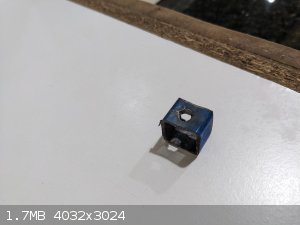
Development of primarily - secondary substances CHP (2015) Lithex (2022) Brightelite (2023) Nitrocelite (2024)
|
|
|
Nu0p
Harmless

Posts: 12
Registered: 25-3-2024
Member Is Offline
Mood: Curious, Determined
|
|
LL, I have detonated the NAP in small quantities, loosely confined, but not in a detonator body. I agree that the NQ is not needed as the NAP will
serve as both the primary and secondary. I am using the NQ because at this point I feel more comfortable pressing it and the reagents are easier for
me to come by in quantity. I also want to see if the NAP will successfully detonate the NQ. I see your point however and I will add an NAP detonator
to the testing and get a good baseline.
|
|
|
underground
National Hazard
   
Posts: 698
Registered: 10-10-2013
Location: Europe
Member Is Offline
|
|
The problem with NQ is that it can not be pressed in high density. Does the PTFE help to press it in higher densities ? Also it in very insestitive. A
mixture of ETN/NQ or AP/NQ would be better.
[Edited on 18-4-2024 by underground]
|
|
|
dettoo456
Hazard to Others
  
Posts: 178
Registered: 12-9-2021
Member Is Offline
|
|
Sensitized NQ would be a good output charge but it just has too low density to be practically useful. MeNQ or EtNQ would likely be better since their
performance and sensitivity is similar to NQ, but they have higher density and can be melt cast at high temperatures if need be. The alkyl derivatives
of NQ only require NQ & an alkyl amine to be refluxed whilst vacuuming off excess NH3 produced in the alkylation.
Another option could be (N-nitroguanyl)urea, if that is even isolatable. Dehydration of guanylurea nitrate or cyanation of nitroguanidine with
potassium cyanate & acid might be possible routes.
|
|
|
underground
National Hazard
   
Posts: 698
Registered: 10-10-2013
Location: Europe
Member Is Offline
|
|
That is interesting. Nice observation. Calcium cyanate is very easy to make from urea and CaOH. I believe dinitroguanylurea would be interesting too,
or salts of nitroguanylurea. Calcium cyanate is a lot easier to produce than methylamine
Guanidine nitrate actually can be reacted with calcium cyanate to produce guanylurea nitrate, then H2SO4 to nitroguanylurea. Has this even been tried
?
[Edited on 18-4-2024 by underground]
|
|
|
Nu0p
Harmless

Posts: 12
Registered: 25-3-2024
Member Is Offline
Mood: Curious, Determined
|
|
In all three cases the secondary failed to detonate.
I am quite pleased that the electronic matches worked well, however. I was able to reliably set off the charges over 100 feet of RG-174 using only a 9
volt alkaline battery. I didn’t like the delay at that voltage, however, and I will be increasing it to 18 volts for the next cycle.
Two things made the NQ easier to press. I did a wet grind in water and dried to get powdered NQ at 0.735 g/cc. This powder was then blended with the
PTFE which reduces friction while pressing and acts as a binder. I know that I could take it above 1.4 g/cc as I didn’t have to press very hard to
get there.
I’m currently curious about PrNQ, and EtNQ. I’d like to see what happens at higher densities, and if I press the NAP harder against the secondary.
I’m also interested in LL’s suggestion. Photos attached. I have a thick plastic planter which is set down into a hole in my woods, then covered
with another planter. It deadens the noise quite a lot.
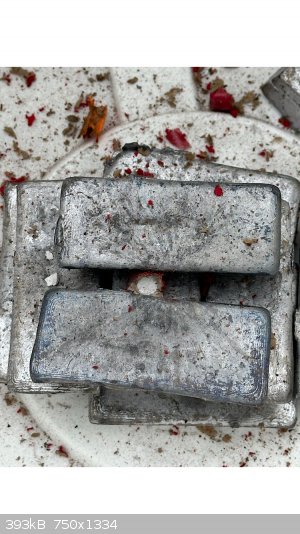 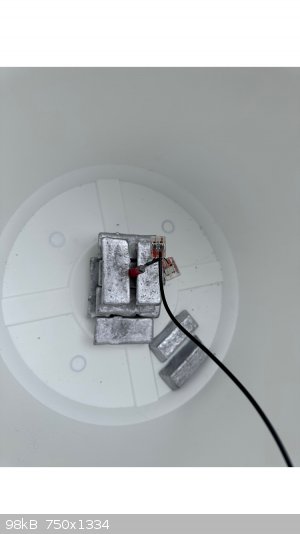 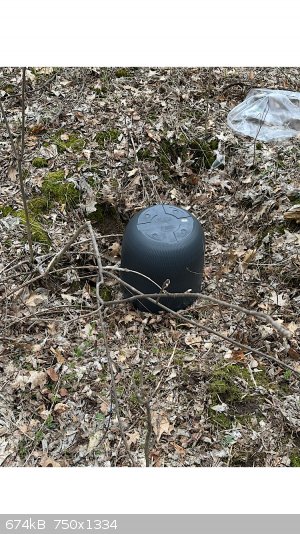
|
|
|
dettoo456
Hazard to Others
  
Posts: 178
Registered: 12-9-2021
Member Is Offline
|
|
The NQ is probably just too insensitive - most other primaries in the 100mg range likely wouldn’t be able to set it off either in the conditions you
used. A metal case to aid in confinement may help to get the NQ going but I don’t think it’d be worth the trouble of making. PETN and RDX are the
gold standard for output charges; 750mg of either is enough to get a train started fairly reliably.
PETN pressed lightly by hand w/ a hard plastic rod should achieve a plenty high VoD, especially since it’s VoD isn’t very density dependent.
Small, cast boosters of alkyl-NQ mixed with NQ could be interesting seeing as NQ is already so cheap and a little <10g booster should be able to
reliable set off secondaries & tertiaries like ANSU.
And you should look into getting a legit electric blasting machine - either by building one from a flash capacitor circuit or buying a used one for a
couple hundred $. UXO, especially from sending stray 9V current into it, is no joke and isn’t worth losing a finger, eye, or hand from. Or just use
good old time fuse.
|
|
|
Nu0p
Harmless

Posts: 12
Registered: 25-3-2024
Member Is Offline
Mood: Curious, Determined
|
|
Quote: Originally posted by dettoo456  |
And you should look into getting a legit electric blasting machine - either by building one from a flash capacitor circuit or buying a used one for a
couple hundred $. UXO, especially from sending stray 9V current into it, is no joke and isn’t worth losing a finger, eye, or hand from. Or just use
good old time fuse. |
Does anyone have a lead on one? A few hundred $ I can swing, but a few thousand is not in the cards at the moment. I’ll also look into building one.
|
|
|
Nu0p
Harmless

Posts: 12
Registered: 25-3-2024
Member Is Offline
Mood: Curious, Determined
|
|
Alright, I did another run. This time I used as LL suggested and pressed 300 mg NAP to 1.7 g/cc, then topped it off with 100 mg loose fill in contact
with a good old fashioned fuse until I can get my hands on the proper equipment. There was no deformation at all in the lead block. Perhaps I need a
metal casing for this?
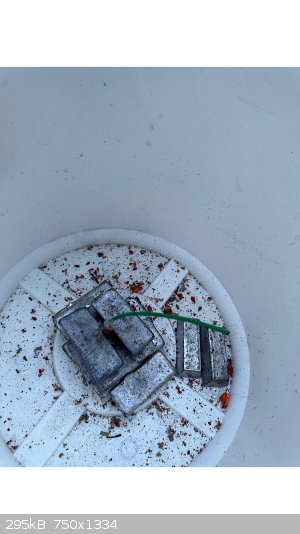 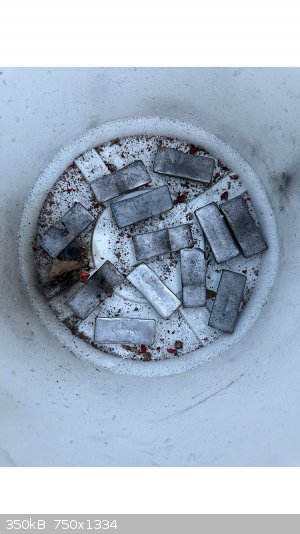
Perhaps my math is wrong? With a 5.7mm diameter I calculated that I would need to press 300 mg down to a height of 6.91 mm to achieve 1.7 g/cc
[Edited on 19-4-2024 by Nu0p]
|
|
|
dettoo456
Hazard to Others
  
Posts: 178
Registered: 12-9-2021
Member Is Offline
|
|
The 1.7g/ml is correct, though it could’ve been dead-pressed. I don’t personally know if NAP can or cannot even be dead-pressed, someone else with
more handling experience might.
As for blasting machines, if you’re in the US, just look on eBay, Facebook marketplace, Etsy, Craigslist (I found a super expensive sequential
machine for dirt cheap there), etc. Research Energy Ohio makes somewhat decent ones that take 9V batteries, scorpion too I think. Blasterstool.com
also has their own brand of one for somewhat cheap but you’ll need to fill out a use form and submit your SSID - take that as you may. I’d be
interested in building one too, I think a flash capacitor circuit from a disposable camera, with high voltage switches to make it safer, and epoxied
into a strong nylon case would be the cheapest option. Those flash capacitors can deal out more V than lots of commercial blasting machines too, and
they only need a 9V or 2 AAs in most cases. They’re dirt cheap too.
[Edited on 19-4-2024 by dettoo456]
|
|
|
Nu0p
Harmless

Posts: 12
Registered: 25-3-2024
Member Is Offline
Mood: Curious, Determined
|
|
Quote: Originally posted by dettoo456  |
Small, cast boosters of alkyl-NQ mixed with NQ could be interesting seeing as NQ is already so cheap and a little <10g booster should be able to
reliable set off secondaries & tertiaries like ANSU.
|
I’m going to look into PrNQ. Propylamine is hard to come by but not impossible. I’ve read that there are valid routes using Propyl Iodide as well.
How much ETN would I need to add to the melt cast PrNQ to sensitize it in order to make a booster? 10% by mass?
|
|
|
dettoo456
Hazard to Others
  
Posts: 178
Registered: 12-9-2021
Member Is Offline
|
|
You’d be better off just buying the propylamine IMO, Sigma sometimes has sales on their less popular reagents, and they had it for around $40/L last
year I believe. 10-30% ETN sounds reasonable, but mixing melt cast ETN with other EMs can cause issues due to weird hydrolysis pathways and partial
reduction of nitro groups on nitramines like NQ. An alkyl NQ with a metal fuel such as Mg/Al, Al, or Mg may be sensitive enough to perform, though
careful heating of that sort of mix would be cause for concern.
|
|
|
Nu0p
Harmless

Posts: 12
Registered: 25-3-2024
Member Is Offline
Mood: Curious, Determined
|
|
Quote: Originally posted by dettoo456  | | An alkyl NQ with a metal fuel such as Mg/Al, Al, or Mg may be sensitive enough to perform, though careful heating of that sort of mix would be cause
for concern. |
Did you intend to say that it would not be cause for concern?
|
|
|
Etanol
Hazard to Others
  
Posts: 138
Registered: 27-2-2012
Member Is Offline
Mood: No Mood
|
|
Verify the critical diameter of NQ at your density with power booster.
I think it is problem.
How is formula of PrNQ and EtNQ? Are you sure that it is able to detonation with such bad oxygen ballance?
|
|
|
dettoo456
Hazard to Others
  
Posts: 178
Registered: 12-9-2021
Member Is Offline
|
|
Quote: Originally posted by Nu0p  | Quote: Originally posted by dettoo456  | | An alkyl NQ with a metal fuel such as Mg/Al, Al, or Mg may be sensitive enough to perform, though careful heating of that sort of mix would be cause
for concern. |
Did you intend to say that it would not be cause for concern? |
Yes, melting organic mixtures of reducing agents can be dangerous. Mg or Al may try to reduce the Nitramine, and cause an exotherm that’d need to be
controlled for.
And Etanol is right about the critical diameter, it just may be too small of a charge. As for OB% for the Alkyl NQs, they are obviously lower, but I
wouldn’t think their VODs would be much lower than say 6000m/s. I can’t quote anything at the moment though. There might be some patent or report
of PrNQ from BAE Systems out there stating its properties; BAE apparently looked into it as a legitimate material for production a while back.
|
|
|
dettoo456
Hazard to Others
  
Posts: 178
Registered: 12-9-2021
Member Is Offline
|
|
https://apps.dtic.mil/sti/pdfs/AD1063959.pdf
https://ndiastorage.blob.core.usgovcloudapi.net/ndia/2013/IM...
|
|
|
Nu0p
Harmless

Posts: 12
Registered: 25-3-2024
Member Is Offline
Mood: Curious, Determined
|
|
Quote: Originally posted by dettoo456  | The 1.7g/ml is correct, though it could’ve been dead-pressed. I don’t personally know if NAP can or cannot even be dead-pressed, someone else with
more handling experience might.
…
I’d be interested in building one too, I think a flash capacitor circuit from a disposable camera, with high voltage switches to make it safer, and
epoxied into a strong nylon case would be the cheapest option. Those flash capacitors can deal out more V than lots of commercial blasting machines
too, and they only need a 9V or 2 AAs in most cases. They’re dirt cheap too.
[Edited on 19-4-2024 by dettoo456] |
There is not a lot of public literature on this, but anecdotally NAP is capable of being pressed to 2 g/cc and beyond. 1.7 should not have dead
pressed it. Maybe it wasn’t in good enough contact with the block. I’m going to try again, because that result really surprised me.
Regarding the detonation machine, I’ll look into this. I can find one rather inexpensively but with my skillset I could benefit the community by
engineering one and writing it up. In the absence of a flash circuit, All you’d really need is a high voltage capacitor, a buck/boost converter,
some high voltage switches and a few terminals. Perhaps an LED to alert you to when it is at the target voltage. All of this is available through
sources like Amazon or EBay.
Thanks for the source material!
[Edited on 19-4-2024 by Nu0p]
|
|
|
Nu0p
Harmless

Posts: 12
Registered: 25-3-2024
Member Is Offline
Mood: Curious, Determined
|
|
Quote: Originally posted by Etanol  | Verify the critical diameter of NQ at your density with power booster.
I think it is problem.
How is formula of PrNQ and EtNQ? Are you sure that it is able to detonation with such bad oxygen ballance? |
What I understand about the critical diameter for NQ is limited. These things are new to me. I’ve been told that it is at minimum 14mm, so when I
pressed it I targeted 14mm as pressing depth. I suspect that you are correct and a 6 mm diameter cylinder that is 14mm long may just not be enough
material.
Is there better source material available on NQ that shows critical diameter as a function of density?
|
|
|
B(a)P
International Hazard
    
Posts: 1117
Registered: 29-9-2019
Member Is Offline
Mood: Festive
|
|
Quote: Originally posted by dettoo456  | The 1.7g/ml is correct, though it could’ve been dead-pressed. I don’t personally know if NAP can or cannot even be dead-pressed, someone else with
more handling experience might.
[Edited on 19-4-2024 by dettoo456] |
It wouldn't have been dead pressed, that photo above attached by LL was from NAP pressed to 2 g/ml.
|
|
|
| Pages:
1
..
13
14
15
16 |